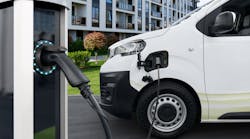The U.S. Department of Transportation on Sept. 27 approved the final batch of states’ proposals to build a national electric vehicle (EV) charging network, setting in motion a $5 billion dollar investment to build EV charging stations over the next five years. The first 33 states and the District of Columbia had their plans approved earlier this month, and the final 17 states were approved Tuesday, according to the Associated Press.
The National Electric Vehicle Infrastructure (NEVI) Formula Program is funded by money allocated from the Infrastructure Investment and Jobs Act. $1.5 billion will be available immediately to be used through the Federal Highway Administration (FHWA) program through fiscal year 2023 to build EV charging stations every 50 miles in every state and Puerto Rico—across about 75,000 miles of highway in total.
Each state's plans are available from the FHWA website. The amount of NEVI funding allocated to each state is also available.
See also: Industry reacts to proposed national charging station network
The stations must support at least four charging ports, each able to provide at least 150 kW simultaneously for a total of 600 kW. While this wattage is not sufficient to quickly charge heavy-duty trucks, the plan requires that states build stations designed to accommodate future expansions needed to meet the requirements of heavier vehicles.
“America led the original automotive revolution in the last century, and ... we’re poised to lead in the 21st century with electric vehicles,” said Transportation Secretary Pete Buttigieg, adding that the plans will “help ensure that Americans in every part of the country—from the largest cities to the most rural communities—can be positioned to unlock the savings and benefits of electric vehicles.”
The Biden administration’s goal is that 50% of new U.S. car sales be electric by 2030. To achieve this, in addition to creating the national charging network to assuage EV range anxiety, the Inflation Reduction Act includes clean vehicle tax credits. The Qualified Commercial Clean Vehicle credit is worth up to $40,000 for commercial vehicles not using gasoline or diesel internal combustion engines.
See also: Using the Inflation Reduction Act to scale EV adoption
Charge port, grid capacity concerns for commercial EVs
Last month there was a notice of proposed rulemaking in the Federal Register to gather public comments on the plan, and there were comments from trucking industry stakeholders that the charging ports’ required specifications will not be enough.
American Trucking Associations (ATA) commented that the charging stations should be designed to accommodate 350kW or greater outputs, and that outputs over 1 MW would be ideal for commercial electric vehicles (CEVs).
ATA also stated that “installing truck charging infrastructure every 50 miles along designated alternative fuel corridors is not currently warranted nor economically practical,” responding to the DOT's requirement that states must first focus on direct-current fast chargers (DCFC) one mile or less from highways. ATA stated that CEVs are currently best suited for urban and regional applications.
DOT requires an additional $2.5 billion to be allocated to states via discretionary grants that can be applied to build EV charging infrastructure, as well as hydrogen, propane, and natural gas fueling infrastructure, focusing on rural areas and disadvantaged communities. The FHWA said that it will begin taking applications for those grants later this year.
There is also concern that EVs will overwhelm already-strained electrical grids—a concern underscored by recent grid strain in California as the state battled heat waves.
Vermont, in its grant application, wrote that “Unmanaged or unplanned EV charging could cause utilities to incur significant costs to maintain grid reliability and create challenges for grid operators” and that some locations “may also necessitate intensive grid upgrades and buildout.”




